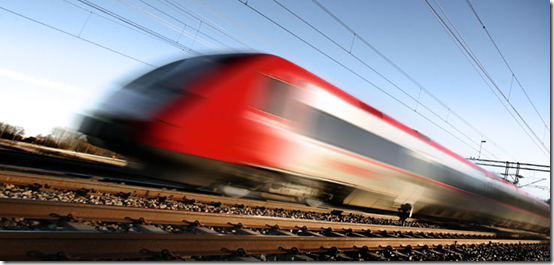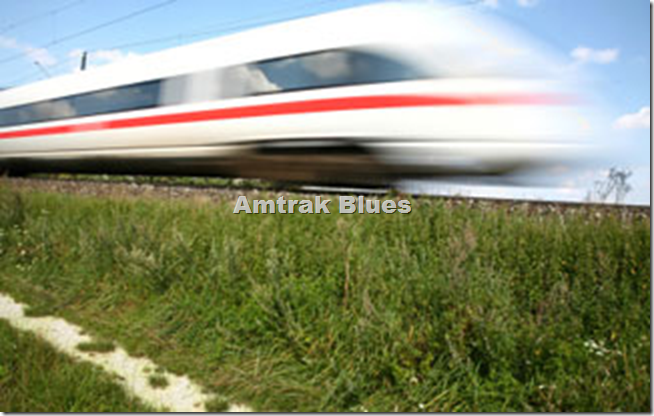
The Wide Angle: Top 10 Fastest Trains
By Jonathan Strickland (HowStuffWorks.com), Discovery Tech.
In the United States, people might think of trains as quaint, outmoded forms of transportation. While many cities have light rail transit or subway systems, the train infrastructure in the United States hasn't evolved much over the last several decades. The majority of Americans rely on cars and planes to get around. But the Obama administration is attempting to change that. President Obama set aside $8 billion to begin construction on the United States' first high-speed railways.
The fastest train in the United States is Amtrak's Acela Express, which travels between Boston and Washington DC, and reaches speeds of up to 150 mph (241.4 kph). But that's less than half of the top speed of the world's fastest train. There are several trains in Europe and Asia that would leave the Acela Express in the dust.
In these nations, the railways remain a vital part of their transportation infrastructures. If the plan to bolster the railways of the United States comes to fruition, we may see similar trains in the United States within a few years.
10. ICE V - 282.8 mph
The first train on our list is the ICE V, also known as the InterCityExperimental train. The ICE V was part of a program in what was then West Germany to push for the most advanced high-speed rail service in Europe. The government of West Germany funded the project in the 1980s.
The ICE V featured two powered locomotives on either end of three passenger cars. The entire train was 372.1 feet long (113.42 meters). On May 1st, 1988, a special version of the ICE V set a new world record for the fastest train, topping out at 282.8 mph (406.9 kph). This version of the ICE V only had two passenger units and upgraded wiring connecting the two locomotives together.
The train entered regular service in 1991. Although capable of traveling at speeds in excess of 350 kph, the train typically operated at slower speeds.
9. Transrapid 06 - 256.4 mph
Another German train that broke speed records was the Transrapid 06, a maglev train. Maglev is short for magnetic levitation. Maglev trains use a series of incredibly powerful magnets to lift and propel the vehicle. Maglev trains tend to be much more smooth and quiet than wheeled trains.
The Transrapid 06 began as a planned test vehicle project in 1980, part of a larger operation called the Magnetbahn Transrapid consortium. In 1983, the consortium commissioned the Transrapid 06. After some modifications in 1987, the train was ready for a high-speed test run.
On a test in 1988, the Transrapid 06 achieved a top speed of 256.4 mph (412.6 kph) at the Transrapid Test Facility in Emsland, Germany. While Germany has not implemented the Transrapid system yet, there are plans to build a track from the Munich airport to the city's central rail station.
8. Aerotrain - 267.3 mph
Jean Bertin, the organizer of the Bertin Company in France, came up with the idea for one of the fastest trains in the world. Instead of running on rails or using magnets, this train used air. Massive jet engines provided the air necessary to lift and propel the train at blinding speeds. And construction on this train began way back in 1965!
The Aerotrain Company built a test track 11.2 miles (18 kilometres) long between the French towns of Ruan and Saran. During one test, the Aerotrain hit a maximum speed of 267.3 mph (430.2 kph). In 1974, the government of France planned to build a track between Paris and Cergy. But two months later, the people of France elected a new governmental administration. The new administration decided to invest instead in maglev technology rather than the air-powered train.
In 1992, a fire destroyed the record-breaking Aerotrain prototype. The cause of the fire was unknown, but French authorities suspected it was set intentionally.
7. MLU002N - 267.8 mph
Just barely edging ahead of the Aerotrain is the MLU002N maglev train from Japan. It's a single-car train that hit a top speed of 267.8 mph (431 kph) in 1994 in an unmanned test. During manned tests, the train's speed topped out at 255.4 mph (411 kph). The train travelled along a 26.6-mile (42.8 kilometres) test track between Sakaigawa and Akiyama.
The train uses a combination of magnets, disc brakes and aerodynamic brakes to slow down from top speed. The aerodynamic brakes act like flaps on the wings of an airplane, increasing drag as they deploy.
While the MLU002N is a test vehicle and not meant for everyday public transportation, it has helped Japanese engineers develop the technology needed to push high-speed rail systems into the 21st century.
6. Shinkansen - 275 mph
The Japan Railways Group has created a network of high-speed rail systems in Japan. You may have heard of the Shinkansen, or bullet trains. These trains travel at high speed between the major cities of Japan. Unlike the maglev or Aerotrain, the Shinkansen are conventional trains that travel on railroad tracks.
In 1996, a test trial of one Shinkansen train reached a top speed of 275 mph (443 kph). The average travel speed for normal commuters is somewhat lower - around 186 mph or 300 kph. Many nations look at Japan's Shinkansen as a model for high-speed railway systems.
A trip on a Shinkansen train from Osaka to Tokyo will take about two and a half hours. If you were to drive, you would need to schedule more than seven hours of travel time.
5. Transrapid 07 - 279.6 mph
It seems like 1988 was a big year for high-speed trains. While the ICE V and Transrapid 06 trains broke speed records, a new train debuted to the German public. It was an experimental train only two cars long called the Transrapid 07. Citizens in Hamburg, Germany, were the first to set eyes upon the sleek maglev train.
On June 17, 1993, the Transrapid 07 hit a top speed of 279.6 mph (450 kph) under normal operating conditions at the TVE test track. The successful test convinced the Magnetschnellbahn Berlin-Hamburg GmbH organization to petition the German government for a national maglev system. The organization's plan was to create a privately operated transportation infrastructure that provided rapid transit between major cities in Germany.
Unfortunately, political manoeuvres and other setbacks side-tracked the project. The Transrapid plan transformed several times until March 2008. At that time, German officials cancelled the project due to rising costs. While Transrapid trains would see success in other nations, Germany never implemented the system.
4. Transrapid 08: Shanghai Maglev Train - 311.3 mph
The Transrapid trains met with more success in other parts of the world. In China, the Transrapid 08, also known as the Shanghai Maglev Train, met with success. The maglev track stretches from the Pudong International Airport to Shanghai's city centre.
Transrapid built the prototype for the Shanghai Maglev Train in 1999, testing it at the Transrapid Test Facility in Emsland, Germany. Once again, Transrapid broke speed records, achieving a top speed of 311.3 mph (501 kph). Chinese officials expressed interest in the technology and began to work with Transrapid to discuss the feasibility of building an 18.6-mile (30 km) long track. Construction began on the project in 2001.
On December 31, 2002, the Shanghai Maglev Train made its maiden voyage, reaching a cruising speed of 267.2 mph (430 kph). However, since the track was only 18.6 miles long, the train could only cruise at that speed for a few seconds before the operator started to decelerate the vehicle. Still, the Shanghai Maglev Train remains the only Transrapid vehicle in commercial use today.
3. ML-500R - 321.2 mph
One of the earliest experimental maglev trains was also the fastest. It was the ML-500R, a prototype vehicle that set a blistering pace at the Miyazaki Test Track in Japan. In 1979, a test run of the ML-500R saw the train reach a top speed of 321.2 mph (517 kph) on the 4.3-mile (7 kilometre) track.
The ML-500R was an unmanned test vehicle. Its purpose was to demonstrate the feasibility of the maglev levitation and propulsion system. Engineers working on the project incorporated elements of the ML-500R's design into future MLU models (such as the MLU002N, number 7 on our list). While the ML-500R didn't carry any actual passengers, it provided engineers the opportunity to fine-tune the techniques that would make maglev technology a viable transportation system.
2. TGV Est V150 - 357.2 mph
In 2007, French technicians proved that maglev trains aren't the only vehicles that can tear up the track. The Alstom-designed TGV train features an engine on either end of a series of three double-decker cars. Like a conventional train, the TGV has wheels that ride on top of a track. Unlike a conventional train, the TGV moves incredibly fast.
The record for the TGV is 357.2 mph (574.8 kph). The trip was made on a track that links Paris to Strasbourg. In order to attain such a high speed, Alstom built wheels larger than earlier TGV trains so that the vehicle would cover more ground each time the wheel rotated. Each engine had 25,000 horsepower. The train pulled power from an overhead electric cable.
The goal of the project wasn't to break speed records or even to provide high-speed transportation in France. Instead, Alstom is trying to sell the high-speed rail technology to nations like China.
1. MLX01 - 361 mph
We've made it to number one on the list. It should come as no surprise that the fastest train in the world uses maglev technology. It's the MLX01 and it's part of the Maglev Chuo Shinkansen Line project in Japan. The purpose of the project is to determine the parameters in which a maglev train may safely operate. Ideally, the train would have a cruising speed of at least 310.7 mph (500 kph).
In 2003, on the 26.6-mile (42.8 kilometre) long Yamanashi track, the MLX01 broke the speed record for trains when it reached 361 mph (581 kph). The test vehicle consisted of three cars and was a manned run.
The maglev train may one day replace the Shinkansen bullet trains in Japan. But that will mean a massive investment in a new infrastructure that spans the country. In fact, plans to build a track between Tokyo and central Japan estimate the cost at more than $44 billion. The Japan Railway Co. says that it will complete the project by 2025. For now it sounds like maglev is going nowhere fast.
Trains have come a long way since the days of steam engines and coal-fired locomotives. And with a renewed interest in train technology in the United States, we may see a global resurgence in competition among technicians to see who can ride the rails faster than anyone else.
[More information here and here] [Watch video]

Have you ever thought about adding a little bit more than just
ReplyDeleteyour articles? I mean, what you say is fundamental and all.
Nevertheless think about if you added some great
images or videos to give your posts more, "pop"! Your content is excellent but with pics and videos, this website could undeniably be one of the very best in its niche. Excellent blog!
My website ... Best Brand name Laptop